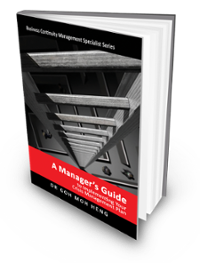A Plan that Matches Response Modules to Crisis Scenarios
This core plan links each of the planning scenarios to the response modules that will be immediately activated.
For example, a "shooter on-site" event triggers an immediate facility lockdown, a police response, and pre-set communication protocols to convene the crisis-response team and warn staff.
CM Plan Development
 Businesses may be affected at any time by crises that threaten the safety of staff, the continuity of operations and confidence in reputation.
Businesses may be affected at any time by crises that threaten the safety of staff, the continuity of operations and confidence in reputation.
Staff must be ready to respond rapidly and effectively to such situations, as action taken in the early stages of a crisis will be crucial to achieving a successful outcome.
This plan contains a framework for managing and resolving severe incidents that may affect business operations. It controls a small team of key staff responsible for initiating a rapid and coordinated response.
Threats (Crisis Types)
 Businesses must be prepared to deal with the following:
Businesses must be prepared to deal with the following:
- Natural
- Technological
- Confrontation
- Malevolence
- Organisational Misdeeds
-
- Skewed Management Values
- Deception
- Management Misconduct
- Workplace Violence
- Rumours
- Lack of Fund
- Due to Natural Factors
Crisis Management (CM) Objectives
 The key objectives in managing a crisis are to:
The key objectives in managing a crisis are to:
- Ensure the health, safety, and welfare of staff and customers.
- Control the immediate situation and continue business operations with minimum disruption.
- Restore the business to normality as quickly as possible.
- Minimise loss or damage and maintain business confidence.
- Maintain effective internal and external communications with customers, the media, and regulatory bodies.
Response to Emergencies
When an emergency has serious implications for the entire business (see Crisis Types), the Incident Management (IM) Team Leader One will advise the IM Team Leader Two or, if not available, the IM Team Leader Three to activate ABC COMPANY LIMITED’s CM Plan.
Crisis Management Team
 Once the CM Plan is activated, the CM team will meet to decide what action needs to be taken to protect the business's broader interests and how best to support the individual CM Team Leaders dealing with the incident.
Once the CM Plan is activated, the CM team will meet to decide what action needs to be taken to protect the business's broader interests and how best to support the individual CM Team Leaders dealing with the incident.
Core CM Team Members
- Chief Executive Officer.
- Chief Operations Officer.
- Chief Financial Officer.
- Other directors as appropriate.
- Chief Legal Counsel /Company Secretary.
- A coordinator/administrative assistant.
Co-Opted CM Team Members
This will depend on the type of emergency and may include, as required:
- Head of Human Resources
- Head of Audit
- Head of Information Technology
- Head of Business, as appropriate.
Responsibilities
 The primary responsibilities of the CM Team include:
The primary responsibilities of the CM Team include:
- Confirm the composition of the ABC COMPANY LIMITED Incident Management Team dealing with the event.
- Define responsibilities and authorities for managers within this team and across the organization, and supervise their activities.
- Establish financial authorities, including delegated powers and levels.
- Establish procedures for communicating with government and regulatory bodies.
- Refer significant issues to the Chairman or full Board for a decision.
Incident Management (IM) Team
The ABC COMPANY LIMITED’s Incident Management Team will immediately come together and:
- Manage the incident locally.
- Liaise with the emergency services.
- Take action to protect staff and recover assets.
- Ensure the continuity of business operations.
Core IM Team Members
- Area or Local Branch Manager.
- Local Premises Manager and Head of Administration.
- Manager IT.
- Functional business managers.
- A Coordinator or administrative assistant.
IM Team Coordinators
The role of the Coordinator is critical to the success of the emergency response. Unlike other members of the team, whose responsibilities remain broadly functionally based, coordinators will:
- Establish and secure Command Centres or, if not available, locations that can be suitable, equipped, and run.
- Convene meetings and prepare agendas and minutes.
- Report to senior management as required.
- Maintain comprehensive records of the incident, particularly all decisions and the reasons they were taken.
Activating the Plan
All incidents should be reported first to IT Team Leader Two or, in his absence, IM Team Leader Three. The IM Team Leader Two will confirm the seriousness of the incident and, if appropriate, notify IM Team Leader One.
IM Team Leader One will:
- Confirm the information and nature of the emergency
- Decide whether to activate ABC COMPANY LIMITED’s CM Plan if the local incident warrants such action.
In deciding whether to activate the IM, Team Leaders should use the following general considerations.
General Considerations
- Have the implications of the incident been fully established?
- Can the incident be managed effectively by a single manager?
- Does the IM Team Leader/business have the resources to deal with the situation effectively?
- Is the incident likely to attract media attention?
- Could the incident seriously affect the reputation or liquidity of ABC COMPANY LIMITED?
- Will the situation continue and escalate, is the outcome uncertain?
- Is the government and other regulatory bodies likely to be involved?
- If the police and other authorities have been consulted, is their advice consistent with initiating the plan?
Incidents that will Activate the Plan
 Denial of buildings and resources. (Refer to BC Plan – Not Included)
Denial of buildings and resources. (Refer to BC Plan – Not Included)- Terrorism, Civil Unrest and Demonstrations
- Kidnap and Hostage Situations
- Extortion/ Blackmail
- Threats Against People
- Threats Against Property
- Industrial Actions
Immediate Actions by Incident Management Teams
- Take any immediate action required to contain the situation
- Activate the Command Centre
- Start a diary of events
- Obtain all relevant information
- Decide initial actions and objectives
- Nominate a spokesperson, if necessary, and prepare an initial press statement.
- Inform ABC COMPANY LIMITED staff of the incident and what they should do next.
- Review security arrangements and establish secure communications
- Notify third parties as necessary (police, regulators)
External Contact and Communications
Effective communication is essential to maintaining a sense of order and reassuring both staff and the public. Failure in this regard could damage the reputation and profitability of ABC COMPANY LIMITED.
The Board (Crisis Management) Team must control contact with customers, the media, and external agencies in a crisis. If necessary, the Chairman will communicate personally with the public, the media, regulators and other institutions.
Staff
Remind staff that they are not to talk to the media and explain the preferred method of dealing with requests for information from outside the company.
Contact Telephone Numbers
Manager Two is responsible for maintaining lists of emergency telephone numbers for all key Incident Management Team staff members and will keep up-to-date lists of all key contacts for their area of responsibility.
Contact numbers must be updated immediately after changes are made.
Preparation
Risk Control
Employees at all levels can help eliminate and reduce exposure to crises by ensuring that they comply with policies and standards in areas such as operational risk, security, and health and safety.
Planning
- Manager Two is responsible for producing, maintaining and validating the CM Plan.
- Plans should be tailored to meet the business's particular needs and will include matters such as Business Continuity and IT Disaster Recovery.
- Team members should be named, and specific responsibilities should be allocated to these plans.
Threat Monitoring
The Premises Manager is responsible for monitoring environmental threats and providing warnings of impending crises.
The appropriate Functional Heads, in conjunction with Manager One, are responsible for monitoring business threats.
Training and Evaluation
Manager Two is responsible for devising and implementing a crisis management training and evaluation program jointly with the Managing Director.
Command Centres
Incidents likely to last more than a few hours are best managed from Command Centres, separate from areas where routine business is conducted.
Command Centres can either be dedicated rooms set aside and equipped for immediate use or offices earmarked for emergencies with essential equipment identified in advance.
Care of Staff
Reliable means of relaying information and instructions concerning crises to staff at work and home should be devised at all levels throughout the organisation.
To achieve this, telephone trees/call-out lists should be drawn out of regular office hours to ensure that messages reach all staff.
Incident Action Lists
 The following pages contain action points for crises. These are not exhaustive, nor will all points be appropriate in every circumstance.
The following pages contain action points for crises. These are not exhaustive, nor will all points be appropriate in every circumstance.
They are intended to assist in formulating detailed plans for specific situations and include:
- Denial of buildings and resources. (Refer to BC Plan – Not Included)
- Terrorism, Civil Unrest and Demonstrations
- Kidnap and Hostage Situations
- Extortion/ Blackmail
- Threats Against People
- Threats Against Property
- Industrial Actions
An outline is also given for preparing to equip and establish an emergency response centre.
Denial of Critical Buildings and Resources
Having verified and assessed the nature and extent of the problem
Refer to implementing the Business Continuity and IT Disaster Recovery Plan as appropriate.
Command Centre
Goh, M. H. (2016). A Manager’s Guide to Implement Your Crisis Management Plan. Business Continuity Management Specialist Series (1st ed., p. 192). Singapore: GMH Pte Ltd.
Extracted from Appendix 6: CM Plan Template
More Information About Crisis Management Blended/ Hybrid Learning Courses
To learn more about the course and schedule, click the buttons below for the CM-300 Crisis Management Implementer [CM-3] and the CM-5000 Crisis Management Expert Implementer [CM-5].










![[BL-CM] [5] Register](https://no-cache.hubspot.com/cta/default/3893111/82024308-16f4-4491-98be-818a882c6286.png)

![Email to Sales Team [BCM Institute]](https://no-cache.hubspot.com/cta/default/3893111/3c53daeb-2836-4843-b0e0-645baee2ab9e.png)





